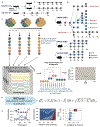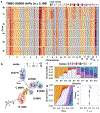Clonal fitness inferred from time-series modelling of single-cell cancer genomes
- PMID: 34163070
- PMCID: PMC8396073
- DOI: 10.1038/s41586-021-03648-3
Clonal fitness inferred from time-series modelling of single-cell cancer genomes
Abstract
Progress in defining genomic fitness landscapes in cancer, especially those defined by copy number alterations (CNAs), has been impeded by lack of time-series single-cell sampling of polyclonal populations and temporal statistical models1-7. Here we generated 42,000 genomes from multi-year time-series single-cell whole-genome sequencing of breast epithelium and primary triple-negative breast cancer (TNBC) patient-derived xenografts (PDXs), revealing the nature of CNA-defined clonal fitness dynamics induced by TP53 mutation and cisplatin chemotherapy. Using a new Wright-Fisher population genetics model8,9 to infer clonal fitness, we found that TP53 mutation alters the fitness landscape, reproducibly distributing fitness over a larger number of clones associated with distinct CNAs. Furthermore, in TNBC PDX models with mutated TP53, inferred fitness coefficients from CNA-based genotypes accurately forecast experimentally enforced clonal competition dynamics. Drug treatment in three long-term serially passaged TNBC PDXs resulted in cisplatin-resistant clones emerging from low-fitness phylogenetic lineages in the untreated setting. Conversely, high-fitness clones from treatment-naive controls were eradicated, signalling an inversion of the fitness landscape. Finally, upon release of drug, selection pressure dynamics were reversed, indicating a fitness cost of treatment resistance. Together, our findings define clonal fitness linked to both CNA and therapeutic resistance in polyclonal tumours.
© 2021. The Author(s), under exclusive licence to Springer Nature Limited.
Conflict of interest statement
Competing Interests
SPS and SA are shareholders and consultants of Canexia Health Inc.
Figures














Comment in
-
Evolution's cartographer: Mapping the fitness landscape in cancer.Cancer Cell. 2021 Oct 11;39(10):1311-1313. doi: 10.1016/j.ccell.2021.09.002. Epub 2021 Sep 30. Cancer Cell. 2021. PMID: 34597592 Free PMC article.
-
Probing clonal dynamics with single-cell genomics.Nat Cancer. 2021 Dec;2(12):1289. doi: 10.1038/s43018-021-00311-8. Nat Cancer. 2021. PMID: 35121909 No abstract available.
References
Publication types
MeSH terms
Substances
Grants and funding
LinkOut - more resources
Full Text Sources
Other Literature Sources
Research Materials
Miscellaneous

